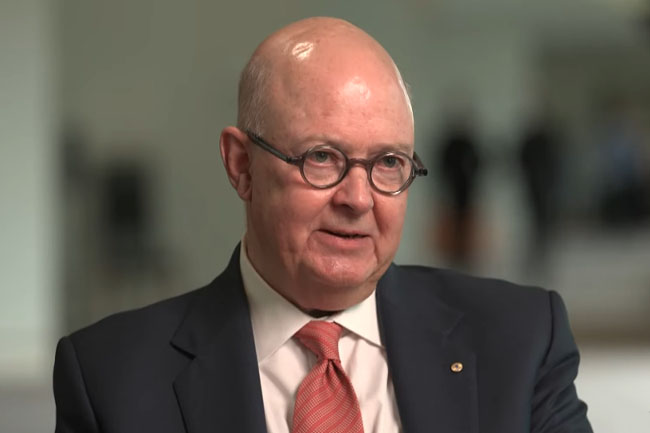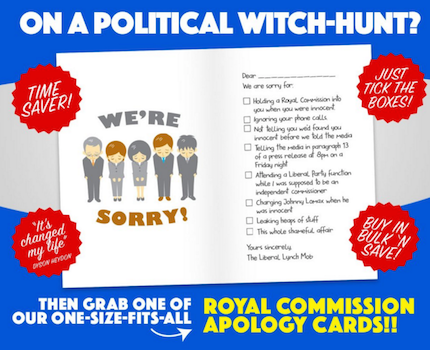I DO NOT THINK all Australians have quite grasped the dangers of the money-losing, tax-evading, propaganda-feeding newspapers that Rupert Murdoch uses to blanket almost every corner of our country.
It is described by a 1987 editorial published in Melbourne's The Age newspaper, that has been quoted several times by media writers:
'The effective control of the media is the first step on the road to controlling the values and future direction of our society.'
In the 1950s, when Rupert had taken control of The News in Adelaide, I had joined the Murdoch family business at Southdown Press in Melbourne and became a favourite with Rupert, spending a long time with him on various ventures — like his failed attempt to capture The Age, which Fairfax was about to buy.
I presented him with a plan for a national newspaper by buying the Canberra Times, which was then owned by the Shakespeare brothers, Arthur and Bill.
Rupert bounded off to Canberra and tried to bully them into selling their paper, with his usual mixture of charm and vague threats. Both elderly and ready for retirement, the brothers were alarmed and Bill – who had a good relationship with Fairfax – flew down to Sydney and clinched a deal that left Rupert out in the cold.
My plan was based on a longer term introduction of offset printing using the new electronic developments that have now made newspapers easier to publish, faster to print, cheaper to manufacture and can be published simultaneously all over the country. But Rupert, ever impatient to extend his power, went on to start The Australian, building his own publishing house in Canberra.
What followed was a disaster of chaos and errors, but there was also excitement in the newspaper industry and some fine journalists flocked to became part of the Murdoch plan. For many reasons, the first years of the The Australian (which celebrates its 50th anniversary this year) were a grim embarrassment. The paper came out late, had to be flown around Australia in light aircraft, sometimes blocked from take-off by winter fog — a feature of the Canberra climate.
They arrived late in the capital cities and newsagents could only deliver them with the afternoon papers. It was a paper competing for readers with yesterday’s news.
Nevertheless, I rose through the ranks of News Limited – as it was then – but I wanted to get away. Rupert was chopping and changing editors and colleagues whom I had admired, hiring people I would have rejected and firing ones I truly admired. His understanding of journalism – its ethics and principles I respected – all seemed torn away by his reckless and burning ambitions.
Referred to as “young Murdoch,” with no respect for the Norton papers he owned – the Sydney Daily Mirror the Melbourne, Sydney and Brisbane Truth – the politicians of the day gave him little time.
Except one. John 'Black Jack' McEwen, head of the Country Party in the Menzies Coalition – who hated Menzies and his weak little shadow – Billy McMahon, who was deep in Sir Frank Packer’s pocket.
With McEwen’s help, feeding The Australian with stories of the savage differences between the MPs of the Liberal Party and the Country Party, Murdoch suddenly became a serious presence.
At this point, I would like to say that Jack McEwen was one of the finest men in politics in Australia. He served as a soldier in World War II, worked on the Melbourne wharves to raise money and turned his Sunraysia soldier settlement farm into a fine and prosperous property. He was a good friend and, without some of the help McEwen gave him, Rupert today might at best have owned two or three papers in Australia and none elsewhere. Without McEwen’s help, Rupert would never have been able to achieve his ambitions in Britain, but that is another story in my archives.
Although I had a place in the management of The Australian for a time, I wanted to get away from the fights and arguments and the sackings of my friends. Rupert offered me a term at The News in Darwin and the Advocate in Alice Springs, both badly run down and money-losing papers owned by businessmen in the Territory and started originally to provide advertising for their businesses. I spent four years in the Territory bringing both papers into profit and securing the TV licence for NTD television in Darwin.
I wanted nothing more to do with The Australian.
How silly can it get? Murdoch propaganda sheet The Australian says you ain't suffering Labor made it up! #auspol pic.twitter.com/lF8T5YQvv3
— chris murphy (@chrismurphys) May 23, 2014
But thanks to Bob Hawke and Paul Keating, my life was to change once again. As Keating put it, proprietors were allowed to be “queens of the screen or princes of print” plan, which allowed Rupert to expand his newspaper operations nationally and unrestricted. Unfortunately, this also saw my TV licence in Darwin sold off to another TV company and I found myself and my family ordered to Brisbane – the city of my birth – to try to lift one of the worst run-down newspaper establishments I had ever seen.
Equipped with 100-year-old printing equipment still churning out news on leaden typescript, and continually breaking down, Brisbane was a nightmare assignment. The presses were so old that they were dangerous and frequently tore the rolling newsprint into shreds.
We were printing three newspapers, The Australian, the weekend Truth and a rural newspaper called the Queensland Country Life. We had a good staff, but a printing plant that had been put together by John Norton in the 19th century. The business urgently needed rebuilding of the whole plant in a new building. The old one was desperately in need of a bulldozer. But there was no money. News Limited was broke. Rupert had gone to live in England and had taken all the money with him to buy newspapers there.
It was the time when Rupert was courting Margaret Thatcher and ensuring his survival in Britain. He promoted her brutal economic policies and gave her and her subsequent followers the wasteful and unnecessary wars that tend to take people’s minds off their own troubles. In return, Thatcher, Blair and other British prime ministers (and the British police) grovelled under the power of the Murdoch papers.
Rupert came to see me in Brisbane and made it clear that there was no money to spare for our needs.
It was during that visit he urged me to persuade the Queensland Premier, Joh Bjelke-Petersen, to remove his government advertising from the Courier-Mail, then part of the old Herald and Weekly Times group and not yet in Rupert’s control, and put it in The Australian. I laughed. I thought he was kidding, perhaps mentally deranged after his flight from London. I brushed the idea aside. The Australian had a minuscule circulation compared with Queensland’s leading newspaper.
What happened after that I have explained in more detail in another article in the archives of Independent Australia. In brief, after Rupert had gone back to the UK, I received an order from Ken May, then the acting head of News Limited, to go and see Joh and put the scheme to him. I flew down to see Ken May in his office in Sydney and placed my resignation on the table.
I told him:
“I am a journalist. I am not a lobbyist who bribes politicians.”
My career with News was over.
It was a relief. I went to Caloundra and lay in the sun on King’s Beach and developed a melanoma (happily, now cured).

This work is licensed under a Creative Commons Attribution-NonCommercial-NoDerivs 3.0 Australia License
Monthly Donation
Single Donation
John Graham's art is available for purchase by emailing editor@independentaustralia.net. See a gallery of John's political art on his Cartoons and Caricatures Facebook page.









